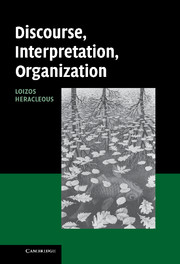Book contents
- Frontmatter
- Contents
- List of figures
- List of tables
- Preface
- 1 Images of discourse: interpretive, functional, critical, and structurational
- 2 Interpretive approaches to organizational discourse
- 3 Functional approaches: metaphor in organization change and development
- 4 Critical approaches: Michel Foucault's conceptions of discourse
- 5 A structurational approach to discourse
- 6 Analyzing discourse I: discourse as situated symbolic action
- 7 Analyzing discourse II: a tale of three discourses
- Index
- References
5 - A structurational approach to discourse
Published online by Cambridge University Press: 22 September 2009
- Frontmatter
- Contents
- List of figures
- List of tables
- Preface
- 1 Images of discourse: interpretive, functional, critical, and structurational
- 2 Interpretive approaches to organizational discourse
- 3 Functional approaches: metaphor in organization change and development
- 4 Critical approaches: Michel Foucault's conceptions of discourse
- 5 A structurational approach to discourse
- 6 Analyzing discourse I: discourse as situated symbolic action
- 7 Analyzing discourse II: a tale of three discourses
- Index
- References
Summary
As noted in chapter 1, interpretive and functional conceptions of discourse tend to privilege the action level of analysis, whereas critical approaches tend to privilege the structural level, each conception illuminating certain aspects of discourse but potentially downplaying other dimensions of the fundamental social processes involved. As a basis for a more encompassing understanding of organizational discourse, this chapter draws on the work of Anthony Giddens to propose a structurational conceptualization. In this approach, discourse is viewed as a duality of communicative actions and deep structures, recursively linked through the modality of actors' interpretive schemes. The chapter concludes by exploring some of the implications of this conceptualization for theory and for the methodology of organizational discourse analysis.
Giddens's Theoretical Project and its Use in Organizational Research
Giddens's structuration theory has had a significant and growing influence in organizational research (e.g. Barley and Tolbert, 1997; Heracleous, 2006; Weaver and Gioia, 1994; Whittington, 1992). Giddens's work aims to transcend persistent dualisms in social theory, especially that of structure and action, proposing among other influential concepts, the notion of “duality of structure,” fostering a view of structure as inherent in agents' (recursive) actions rather than as a distant, external, determining factor. From the perspective of the duality of structure, daily practices (including communicative actions) are manifestations of deeper structures of signification, domination, and legitimation. These structures are not seen as separate from action but are instantiated, reproduced, and can thus potentially be changed through daily practices (Giddens, 1984: 36).
Information
- Type
- Chapter
- Information
- Discourse, Interpretation, Organization , pp. 108 - 132Publisher: Cambridge University PressPrint publication year: 2006
